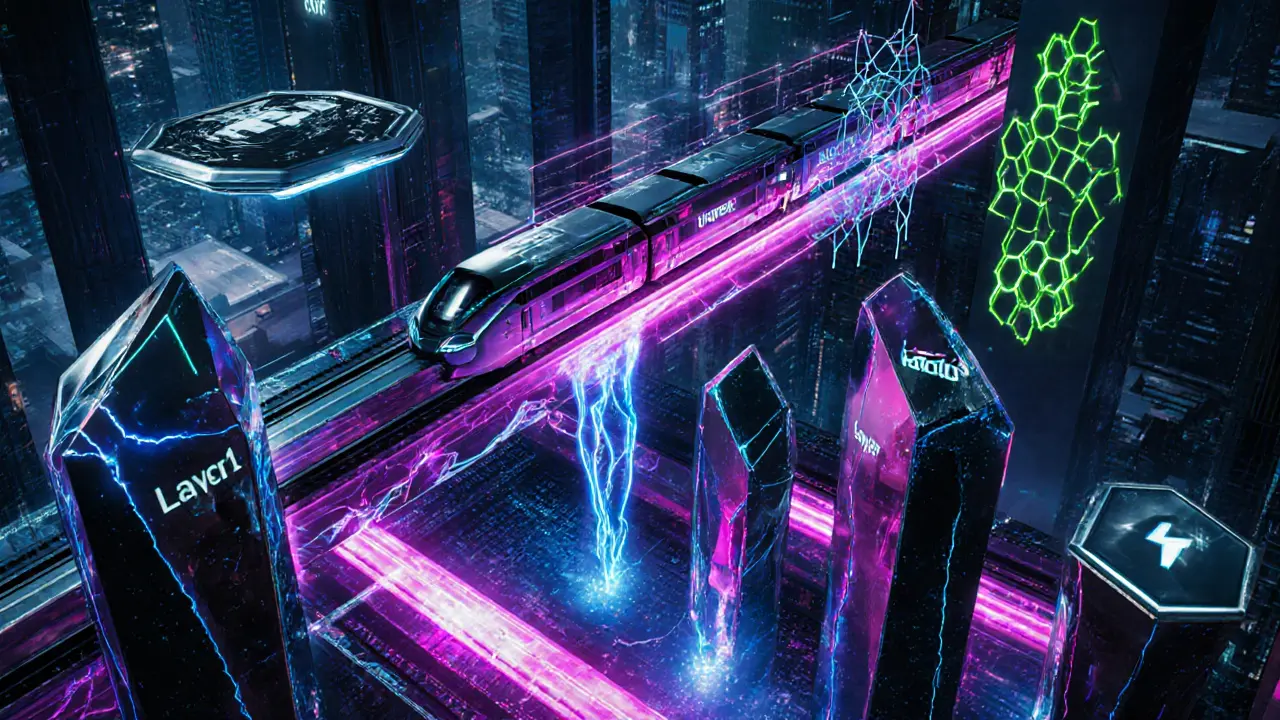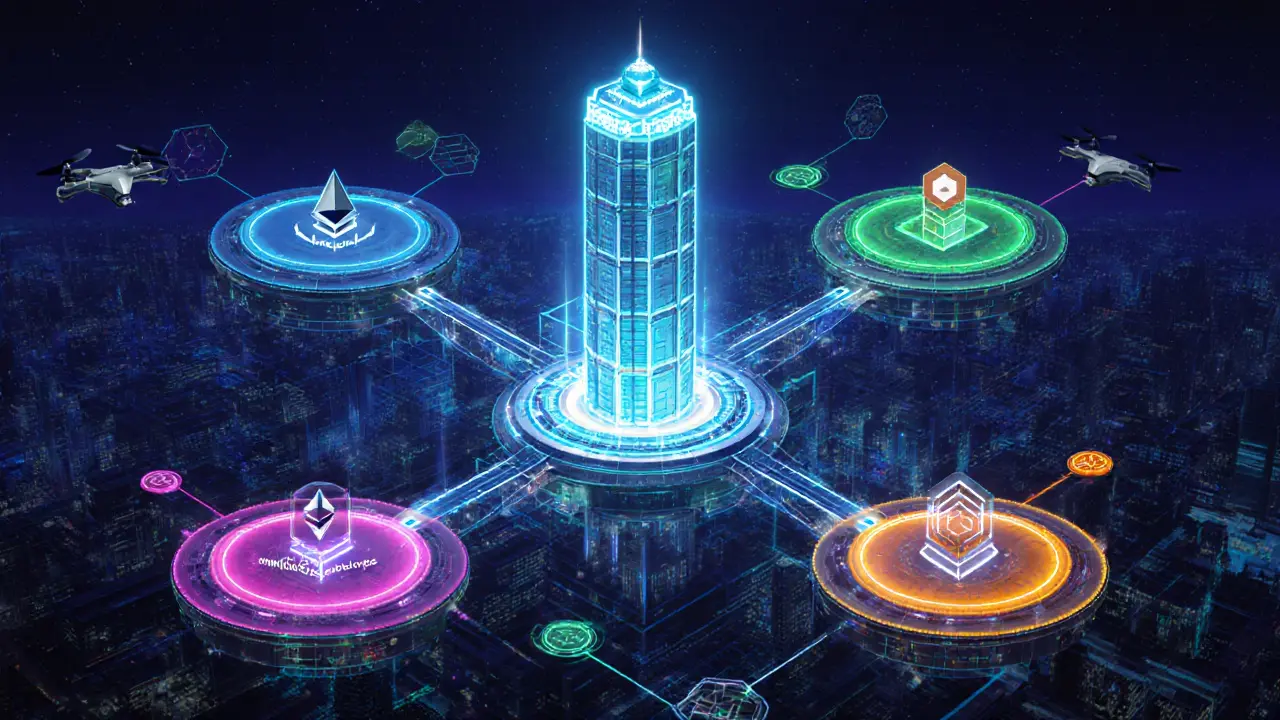Scalability Stack Recommender
When a blockchain platform can’t keep up with user demand, fees spike, transactions stall, and confidence erodes. The good news is that a whole toolbox of cryptocurrency scalability solutions exists to push throughput toward Visa‑level speeds while preserving security and decentralization. This guide walks you through the most important approaches, shows how they compare, and helps you decide which mix works best for your platform.
Quick Takeaways
- Scalability falls into four buckets: Layer1 protocol upgrades, Layer2 off‑chain frameworks, new consensus mechanisms, and alternative ledger designs.
- Layer1 changes (e.g., sharding, block size hikes) need hard forks but give the most permanent performance lift.
- Layer2 solutions like Rollups aggregate many transactions off‑chain and post a succinct proof to the base chain can add 2,000‑4,000TPS today and promise 100× fees reduction after upcoming upgrades.
- Choosing a stack depends on your use case: high‑frequency trading favors sub‑second finality (e.g., Avalanche a PoS network offering 4,500TPS and <1second finality), while NFT marketplaces thrive on cheap, fast Layer2s like Polygon a PoS sidechain delivering 7,000TPS at $0.001 fee.
- Hybrid architectures-combining a robust Layer1 with multiple Layer2s-are becoming the industry norm and are projected to dominate by 2026.
Why Scalability Is the Core Challenge
Early blockchains were designed for trust, not speed. Bitcoin’s 1MB block limit produced backlogs in 2017, pushing average fees to $55 per transaction (CoinMetrics). Ethereum’s 15‑45TPS base layer can’t match the 65,000TPS handled by Visa, limiting DeFi and gaming experiences. The “blockchain trilemma”-security, decentralization, scalability-forces platforms to pick two and sacrifice the third, unless they adopt clever scaling tactics.
Four Main Categories of Solutions
Researchers at MasterTheCrypto (2023) group scalability work into four families. Each tackles the trilemma from a different angle.
- Layer1 scaling protocol‑level upgrades that modify the base chain itself
- Layer2 scaling off‑chain frameworks that settle to an existing blockchain
- Consensus innovations new ways to achieve agreement, often replacing energy‑hungry Proof‑of‑Work
- Alternative ledgers DAGs, hashgraph, and other data structures that bypass the linear chain model

Layer1 Scaling: Changing the Core Protocol
Layer1 upgrades require network‑wide consensus and usually a hard fork, but they provide a permanent capacity boost.
Segregated Witness (SegWit)
Implemented on Bitcoin and Litecoin in 2017, SegWit moves signature data out of the transaction body. Since signatures consume ~65% of block space, effective capacity rises by ~30% without changing the 1MB limit.
Block Size Increases
Bitcoin Cash split from Bitcoin with a 32MB block size, enabling roughly 30× more transactions per block. The trade‑off is a higher barrier to full‑node participation, potentially compromising decentralization.
Sharding
Ethereum 2.0’s Beacon Chain introduced 64 shards (planned up to 1,024). Each shard processes its own transaction set, turning the network into a parallel processing engine. Early testnets show shard‑level throughput around 2,000TPS, and full‑chain capacity could exceed 100,000TPS once fully rolled out.
Proof‑of‑Stake (PoS) Transitions
The Ethereum “merge” in September2022 swapped PoW for PoS, cutting energy use by 99.95% and reducing block time to a steady 12seconds. PoS also enables faster finality and smoother integration of Layer2 rollups because validators can publish proofs more quickly.
Layer2 Scaling: Off‑Chain Superchargers
Layer2 solutions leave the base chain untouched, adding a second execution environment that settles periodically.
Payment Channels - Lightning Network
Lightning, launched in 2018, creates bidirectional channels between participants. By the third quarter of 2023, it processed over $10.5million in daily volume. The network excels at sub‑$100 micro‑payments, but routing failures become common above $1,000, according to Reddit feedback.
Plasma
Plasma builds child chains that periodically commit root hashes to the main chain. A 7‑14day challenge period protects withdrawals, but this latency makes real‑time finance impractical.
Rollups - Optimistic & Zero‑Knowledge
Rollups bundle hundreds of transactions off‑chain and post a compressed proof. Optimistic Rollups (e.g., Optimism, Arbitrum) assume honesty and allow a 7‑day fraud‑proof window. ZK‑Rollups (e.g., zkSync, StarkNet) generate cryptographic proofs that verify instantly, at the cost of higher computational demand.
Both types deliver 2,000‑4,000TPS today, with fee reductions of 10‑100× expected after Ethereum’s upcoming Dencun upgrade (proto‑danksharding).
Sidechains - Polygon
Polygon started as Matic Network in 2017 and now runs a PoS sidechain processing about 7,000TPS with average fees of $0.001 (Q22023). Because it’s a separate chain, security relies on its own validator set, introducing a modest trust trade‑off.
Consensus Innovations & Alternative Ledgers
Beyond tweaking block size, projects are rethinking agreement entirely.
- Avalanche a novel consensus protocol delivering 4,500TPS and sub‑second finality uses a family of three chains (X‑Chain, C‑Chain, P‑Chain) to separate asset creation, contract execution, and validator coordination.
- Hedera Hashgraph’s gossip‑about‑gossip algorithm promises 10,000TPS with asynchronous Byzantine fault tolerance, but its governance model is more permissioned.
- Polkadot’s parachain model lets specialized chains lease a slot on the Relay Chain, sharing security while handling up to 1,000TPS per parachain.
Side‑by‑Side Comparison
| Solution | Category | Peak TPS | Finality | Typical Fee (USD) | Security Model |
|---|---|---|---|---|---|
| Ethereum Sharding (Beacon + shards) | Layer1 | ~100,000 (future) | 12seconds | ~0.001 | PoS validator set |
| Optimistic Rollups (Arbitrum) | Layer2 | 2,500 | 7days (fraud proof) | ~0.002 | Ethereum mainnet security |
| ZK‑Rollups (zkSync) | Layer2 | 4,000 | ~1second | ~0.0015 | Ethereum mainnet security |
| Lightning Network | Layer2 (payment channel) | ~1,000 (effective) | ~milliseconds | ~0.0001 | Bitcoin PoW security |
| Polygon PoS Chain | Sidechain | 7,000 | 2seconds | ~0.001 | Polygon validator set |
| Avalanche C‑Chain | Layer1 (PoS) | 4,500 | ~1second | ~0.001 | PoS with >2,000 validators |

How to Pick the Right Stack for Your Platform
There’s no one‑size‑fits‑all answer. Start by answering three questions:
- What transaction volume do you need? If you target <10TPS, a simple PoS chain may suffice. For >1,000TPS, combine sharding with rollups.
- How critical is finality time? High‑frequency trading or gaming demands sub‑second finality-look at Avalanche or ZK‑Rollups.
- What security guarantees does your users expect? If regulatory compliance demands the strongest proof‑of‑work security, keep Bitcoin or Ethereum as the settlement layer and build on top of it.
Many platforms adopt a hybrid model: use a secure Layer1 for settlement (Ethereum or Bitcoin) while routing everyday activity through a cheap Layer2. This design mirrors Vitalik Buterin’s “multi‑layered” vision and is already the default for DeFi protocols like Aave (uses Optimism for fast trades) and NFT marketplaces that rely on Polygon for cheap minting.
Implementation Tips & Common Pitfalls
Switching to a new scaling stack is a major engineering effort. Below are lessons learned from real‑world deployments:
- Node requirements matter. Lightning nodes need at least 2GB RAM and 50GB storage, and you should expect a setup difficulty rating of 7/10.
- Documentation quality is a make‑or‑break factor. Ethereum’s Rollup docs score 4.1/5 on GitHub, while early Plasma specs suffered 68% implementation failure due to missing details.
- Staff expertise adds cost. Adding Cassandra‑based sharding to a database stack can boost staffing costs by 30‑40%.
- Testing for edge‑case latency. Users report Lightning routing failures for payments over $1,000; simulate high‑value flows before launch.
- Compliance checks. EU’s MiCA requires transparent disclosure of scaling‑related security models-prepare audit reports early.
Future Outlook - What’s Next?
Roadmaps point to three converging trends:
- Proto‑Danksharding (EIP‑4844). Expected to lower Rollup data costs 10‑100×, making mass adoption of ZK‑Rollups viable for gaming and micro‑payments.
- Inter‑chain composability. Polkadot’s parachains and Cosmos‑Ibc enable assets to hop between scaling solutions without losing security.
- Hybrid audit frameworks. Regulators are drafting standards that treat Layer2 settlement proofs as “equivalent to” on‑chain finality, which could open the door for institutional finance on Lightning and zkSync.
Industry surveys suggest 68% of architects believe hybrid approaches will dominate by 2026, while only 22% expect a single framework to win outright. Keeping your architecture modular will let you swap components as the ecosystem evolves.
Frequently Asked Questions
What is the difference between Layer1 and Layer2 scaling?
Layer1 scaling changes the base blockchain protocol itself (e.g., sharding, block size). It requires network consensus and a hard fork but offers a permanent boost. Layer2 builds a separate execution environment that settles to the base chain, adding speed without altering the core protocol.
Are Rollups safe enough for high‑value transactions?
Yes, when they inherit the security of a robust Layer1 like Ethereum. ZK‑Rollups provide instant finality, while Optimistic Rollups rely on a 7‑day fraud‑proof window; most users consider the risk negligible for values under $1million.
How does the Lightning Network handle large payments?
Large payments need multiple hops across well‑liquified channels. If any hop lacks capacity, the payment fails. Solutions like Lightning Loop or multi‑path payments mitigate this, but routing remains a practical challenge above $1,000.
Can I use both Avalanche and Ethereum together?
Absolutely. Bridges like Avalanche Bridge let assets move between Avalanche and Ethereum, letting you run high‑throughput trading on Avalanche while settling final state on Ethereum for maximal security.
What are the regulatory concerns with Layer2 solutions?
Regulators worry about transparency and finality. The EU’s MiCA, for instance, requires firms to disclose the security assumptions of any off‑chain settlement layer and keep audit trails that link Layer2 actions back to the main chain.
Scalability isn’t a single feature you can tick off; it’s a combination of protocols, infrastructure, and operational discipline. By understanding each piece-Layer1 upgrades, Layer2 rollups, consensus tweaks, and alternative ledgers-you can build a platform that stays fast, cheap, and secure as user demand explodes.


Anjali Govind
October 12, 2025 AT 08:23Great overview, really helps to visualize the trade‑offs between Layer‑1 and Layer‑2 options.
Sanjay Lago
October 21, 2025 AT 14:36Totally agree, the guide breaks it down nicely – especially the part about sub‑second finality for trading platforms. I think the Avalanche + ZK‑Rollup combo is definately worth a deeper dive.
Annie McCullough
October 30, 2025 AT 19:49Layer2s like zk‑rollups provide on‑chain data availability proofs while leveraging recursive SNARK verification for scalability :) they also enable O(1) state roots update and cut down latency drastically
Carol Fisher
November 9, 2025 AT 02:03All this tech talk is fine, but we can’t forget the importance of national sovereignty – a home‑grown L1 ensures we aren’t dependent on foreign chains. 🌎💪
Melanie Birt
November 18, 2025 AT 08:16When choosing a scalability stack the first thing to audit is the expected peak TPS versus the average load. If you design for the peak you’ll end up over‑provisioning and raising costs unnecessarily. A good rule of thumb is to size the base layer for roughly 60‑70% of the anticipated maximum, and let a Layer‑2 absorb the remaining burst traffic. In practice this means pairing a sharded Layer‑1 like Ethereum’s upcoming Danksharding with an Optimistic Rollup for general DeFi activity. For high‑frequency trading you’d want to substitute an ZK‑Rollup or Avalanche for sub‑second finality. Make sure the settlement layer has strong economic security – proof‑of‑work chains still offer the highest guarantee, but proof‑of‑stake with a large validator set can be sufficient if you lock enough value. Don’t forget to account for the data availability costs; EIP‑4844 will slash those dramatically, so timing your migration before the upgrade can save millions. The bridge infrastructure is another critical piece – use audited bridges like the Avalanche Bridge or LayerZero to avoid replay attacks. Monitoring latency across the whole stack is essential; set up synthetic transactions that measure finality from the client to the settlement layer. Lastly, incorporate compliance tooling early – MiCA requires you to document the security assumptions of every off‑chain component, so generate audit‑ready logs from day one. By keeping the architecture modular you retain flexibility to swap out components as the ecosystem evolves.
Lady Celeste
November 27, 2025 AT 14:29Sounds like a lot of work, but I guess that's the price of speed.
Scott Hall
December 6, 2025 AT 20:43Exactly, the key is to start small – prototype on a testnet and iterate. You’ll learn a lot about bottlenecks before you go live.
Jade Hibbert
December 16, 2025 AT 02:56Oh wow, another "pick your poison" guide – as if we didn’t have enough to read already. 😂